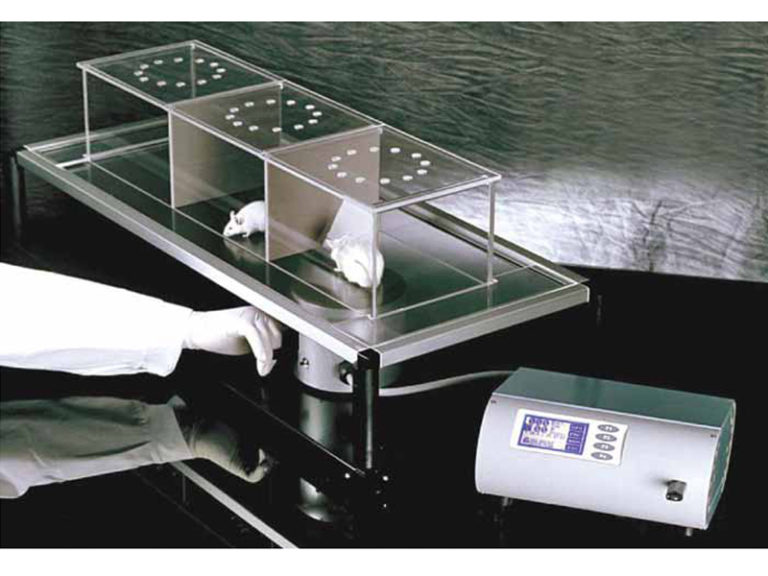Measures paw sensitivity to heat stimulation
Determination of acute nociceptive thermal threshold in laboratory animals has primarily relied upon the tail flick and hot plate methods. Although both methods are used frequently in pharmacological studies, they are not without limitation. In addition, neither method has been extended to investigating behavioural responses to hyperalgesia.
The Plantar Test represents a remarkable advance in methodology, as it combines the best features of all other methods of measuring pain sensitivity. Unique to the Plantar Test, the animal is unrestrained and unhandled during experiments.
The Ugo Basile Plantar Analgesia Instrument is an advance in methodology for assessing pain sensitivity in laboratory animals.
The instrument comes complete with the sliding infrared source; a glass platform; multiple configuration animal enclosure; a controller, and a manual. The Multiple Configuration Animal Enclosure is appropriate for Mice and Rats and provides maximum flexibility.
The Instrument basically consists of:
A Movable I.R. (infra-red) Source
A Glass Pane onto which the Rat Enclosure is located
A Controller
A 3-compartment enclosure for rat or, in alternative a 6-compartment enclosure, convenient for the mouse
After the acclimation period, the I.R. source placed under the glass floor (see the picture) is positioned by the operator directly beneath the hind paw. A trial is commenced by depressing a key. When the rat feels pain and withdraws its paw, the I.R. source switches off and the reaction time counter stops. The withdrawal latency to the nearest 0.1 s is automati-cally determined.
The Thermal Plantar Test Instrument (Hargreave’s Method) measures response to infrared heat stimulus. Focus the infrared source below the Plantar surface and with the press of a button … latency to paw withdrawal and infrared intensity are recorded automatically (i.e. no manual scoring!). The Plantar Test represents a remarkable advance in methodology, as it combines the best features of all other methods of measuring pain sensitivity. Unique to the Plantar Test, the animal is unrestrained and unhandled during experiments.
DATA AQUISITION
This model has a microprocessor controlled unit. The experimental data, stored in its internal memory can be directly exported to the PC USB or serial ports.
Communication is managed by the dedicated CUB Data Acquisition Software Package, included as standard or by the Win-DAS Software.
The CUB Windows®-based Software Package enables the user to route the experimental data to the PC and store them into individual files, to be managed by most statistical analysis packages available on the market.
The model is provided with a memory key, to record all the experimental data of one or more sessions and to program the experiment layouts from a remote PC.
CALIBRATION RADIOMETER
Each Plantar Test Unit is accurately calibrated via an Heat-Flow I.R. Radiometer.
The end user should consider this extremely useful accessory, which enables the experimenter to:
Make sure that two or more units deliver thermal nocicep-tive stimuli (expressed in mW per square cm) of exactly the same intensity.
Know the I.R. energy (1 mW for the duration of 1s corresponds to 1 mJ) in absolute terms
Automatic measurement of hyperalgesia to thermal stimulation in unrestrained animals.
Computer compatibility: direct connection to a PC, via the dedicated software included as standard
PC Interface: USB and serial
Read-out: multifunction liquid-crystal graphic-display
Data Portability: via the Memory-Key provided with the standard package
Print-out: by optional thermal mini-printer
Universal Mains 85-264 VAC, 50-60Hz
Automatic detection of the behavioural end point
Validity unaffected by repeated testing
Greater bioassay sensitivity than other thermal or mechanical tests
Each animal can serve as its own control
Starting: via keys on the I.R. Vessel.
I.R. Intensity: adjustable in the interval 10-99 (in one digit steps)
Reaction Time: three-digit LED display, 0.1s steps
Calibration: via I.R. Radiometer
Related Products
ITEM DESCRIPTION
55370 Ugo Basile Thermal Plantar, Rats & Mice
57390 Ugo Basile Radiometer
57823 Multiple Configuration Animal Enclosure (12 Animals)
57102 Durham Animal Restrainers, Set of 2, 1 medium and 1 large
57390 Heat-Flux Radiometer


